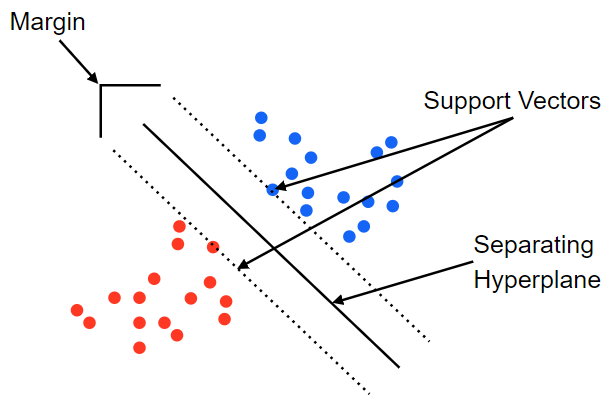SVM (Support Vector Machine)
Fundamental Concept

- The decision boundaries obtained by SVM maximize margin between groups, so learn to have no points belonging to the boundaries and classify them more clearly than logistic regression.
Algorithm
- SVM deals with the problem of binary classification of planes assuming linear and complete classification is possible.
- Maximize the margin between groups to obtain a good decision boundary to classify.
Sample Code
from sklearn.svm import LinearSVC
from sklearn.datasets import make_blobs
from sklearn.model_selection import train_test_split
from sklearn.metrics import accuracy_score
centers = [(-1, -0.125), (0.5, 0.5)]
X, y = make_blobs(n_samples = 50, n_features = 2, centers = centers, cluster_std = 0.3)
X_train, X_test, y_train, y_test = train_test_split(X, y, test_size = 0.3)
model = LinearSVC()
model.fit(X_train, y_train)
y_pred = model.predict(X_test)
accuracy_score(y_pred, y_test)
Margin and Support vector
- If the margin does not contain data, it is called hard margin.
- Allowing some data to be contained in margin is called soft margin.
- Learning data is divided into three categories.
- data outside margin: data outside the margin based on the decision boundary
- margin data: data for determining margin based on decision boundaries
- data inside margin: data that are in margin or misclassified based on the boundary of the boundaries
Hard margin and Soft margin

- The left graph using soft margin is not affected by the fact that the learning results are far away.
- The graph on the right using hard margin is greatly influenced by the point far away.
- How much data in the margin is allowed in soft margin follows the hyperparameters set by the person himself.
참고문헌
- 秋庭伸也 et al. 머신러닝 도감 : 그림으로 공부하는 머신러닝 알고리즘 17 / 아키바 신야, 스기야마 아세이, 데라다 마나부 [공] 지음 ; 이중민 옮김, 2019.




댓글남기기